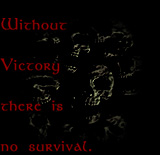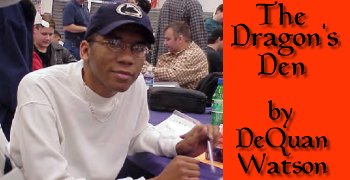|
|
|
|
|
|
|
|
|
|||
 |
||||||||||
|
|
|
|||||||||
 |
|
|||||||||
|
|
||||||||||
|
Rules of Combat
1.13.05 OK,
as promised, here is the breakdown on the combat phase
this week.
The combat phase is broken down into five steps: Beginning of Combat, Declare Attackers, Declare Blockers, Combat Damage, and End of Combat. And just to review, remember that you may not enter the combat step until both players have passed priority in the main phase. BEGINNING OF COMBAT STEP This is the simplest part of combat. "At the beginning of combat" effects and abilities trigger here. Then, the active player will have priority to play instants and activated abilities. And always remember, in each step, the active player passes priority, then the inactive player gets a chance for spells and effects. DECLARE ATTACKERS STEP In this step, the active player declares their attackers. In doing so, all costs that must be paid (including tapping the attacking creatures) in this step. Info attackers are declared, you can skip straight to the end of combat step. If attackers are declared, then abilities that trigger off attackers being declared happen at this point. Then after all of this, the players again have a chance to play instants and abilities. As always priority begins with the active player. DECLARE BLOCKERS STEP In this step, the defending player decides which creatures are blocking and which creatures that are going to stop. Thing to remember is that once you've reached this step, all blocks that have been assigned stay. If you remove a blocker at this point, the attacking creature won't break through. Once it's blocked, it's blocked. Any abilities that trigger when a creature is blocked will trigger here as well. Then both players get a chance to play instants and abilities. The priority still starts with the active player's (the attacker) turn. COMBAT DAMAGE STEP This step is a little lengthy, so try to hang in there. This step includes a "sub-step" to resolve First Strike Damage. First Strike Damage Sub-step If no creatures have first strike, simply skip to the normal combat damage portion of this step. Creatures with First Strike will deal their damage. If there is more than one blocker on a single creature, the attacker gets to decide how damage is distributed among the blockers. Then the defending blockers with First Strike get to assign their damage. After that, you take all damage from creatures with First Strike and place it on the stack. Remember, in the previous portion you just ASSIGNED the damage. In this portion you are preparing for the damage to happen. Each player gets priority for effects before the damage resolves from the stack. After these effects, all damage from First Strike creatures is assigned simultaneously to the appropriate creatures. Next, anything with a "Deals combat damage" or "is dealt combat damage" ability triggers. Both players will then get another chance to play effects. Normal Combat Damage All remaining attackers without first strike get to decide how they are assigning damage to their appropriate defenders. The defending player then decides how the defenders without first strike will assign their damage to the appropriate attackers. All combat damage from creatures without first strike then goes on the stack as one unit simultaneously. As expected, the players will each get priority to play spells and abilities. After all spells and abilities are resolved, the assigned damage is all dealt. As a side note, don't forget that all damage that has been assigned will still happen, whether the creature that it was from is still present or not. This goes for this portion and the First Strike sub-step as well. Again, "Deals Combat Damage" or "Is Dealt Combat Damage" effects will trigger. Each player will then get a chance to play spells and abilities again. END OF COMBAT STEP This is the final step of the combat phase. Anything with an "Until end of combat" effect will end at this point. Then, anything with an "at end of combat" ability will trigger. Both players will then get another chance to play spells and abilities. And the final thing you do (as you do at the end of every phase) is check for mana burn. That's the entire combat step. I'm sure many of you didn't know that it included that many steps. The truth is, the average combat won't even need to go step by step to resolve everything clearly and successfully. Many times, both players understand everything that is going on, so they just fly by certain steps and get to what is important. That's OK too. But, now you have the knowledge to take care of things when you need to. It's important to know how it all works, because you open up more chances to win. The more chances to have to get a big effect, the more chances you have to win right? Knowing when you can play effects is huge. More importantly, I know a lot of players will look over this and have a realization as to what order things happen and resolve. That changes things a lot. Most importantly, I think it's good to know when the "is dealt combat damage" or "deals combat damage" effects come into play. Options are always good to have at your disposal in a strategy game such as Magic. So, I'm going to quit here before I overwhelm some of our readers. However, next week I want you to bring your thinking caps with you. I have a fun idea. How about we do a quiz and go over some interesting situations. Next week we will examine a couple of neat tricks that you can do with the stack. I have a couple of real life situations that we can examine. Until next time, DeQuan Watson PowrDragn at pojo dot com a.k.a. PowrDragn www.thegamecloset.com
|
|||||||||

